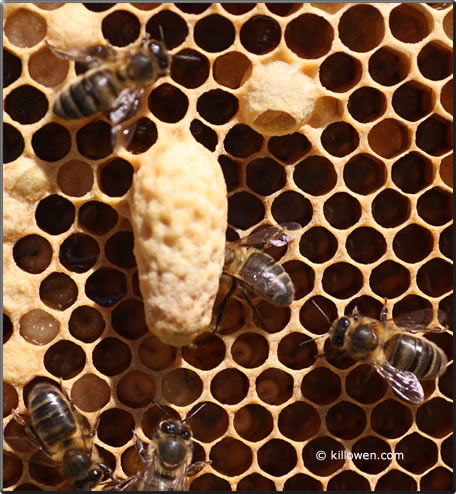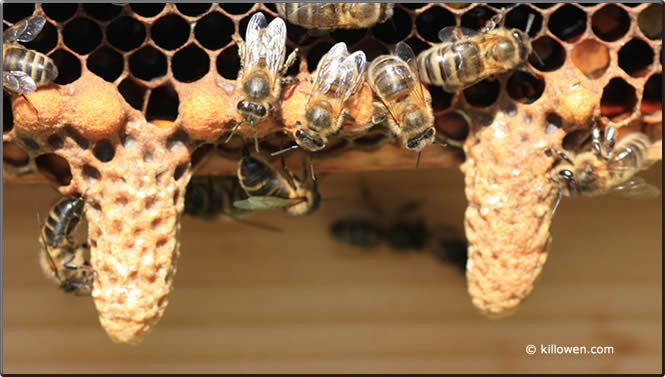
Supersedure
Supersedure characteristics
In his book "The Honeybees of the British Isles", Beowulf Cooper devotes a whole chapter discussing the Supersedure behaviour of the black bee. He emphasizes in particular how Supersedure should be regarded in a positive light, and the advantages of keeping black bees of a Superseding strain.
Whilst it may not be possible for the amateur beekeeper to attain this objective, it is to his advantage to be able to recognize Supersedure during a hive inspection.
Supersedure occurs when the colony senses that their queen is failing. Perhaps she is too old etc. This results in a reduction of queen substance throughout the colony.
Supersedure cells are then built and have the following characteristics:
the cells are built as one batch normally on the face of the comb;
only one, two, or possibly three cell are built;
the supersedure cell can be heavily covered with wax and the comb around the cell indented.
On emergence the new queen is tolerated by the old queen and the two can been seen together often on the same comb.
It is thought that supersedure occurs more often than what the beekeeper might expect. The only way to detect supersedure is to ensure the older queen is marked. She is then seen in the presence of the new one.
My own experience of supersedure is that it is more likely to occur in the late spring or in late summer. In the latter case the new queen (unmarked) is first seen during the examination of the brood nest in early Spring. This always seems to come as a surprise when a marked queen was expected.
What to do if a supersedure cell is found?
The inexperienced might panic and be tempted to destroy it. The experienced beekeeper however, would regard the cell as a piece of good fortune and leave well alone. So letting the bees produce a new queen for themselves.
Whilst it may not be possible for the amateur beekeeper to attain this objective, it is to his advantage to be able to recognize Supersedure during a hive inspection.
Supersedure occurs when the colony senses that their queen is failing. Perhaps she is too old etc. This results in a reduction of queen substance throughout the colony.
Supersedure cells are then built and have the following characteristics:
the cells are built as one batch normally on the face of the comb;
only one, two, or possibly three cell are built;
the supersedure cell can be heavily covered with wax and the comb around the cell indented.
On emergence the new queen is tolerated by the old queen and the two can been seen together often on the same comb.
It is thought that supersedure occurs more often than what the beekeeper might expect. The only way to detect supersedure is to ensure the older queen is marked. She is then seen in the presence of the new one.
My own experience of supersedure is that it is more likely to occur in the late spring or in late summer. In the latter case the new queen (unmarked) is first seen during the examination of the brood nest in early Spring. This always seems to come as a surprise when a marked queen was expected.
What to do if a supersedure cell is found?
The inexperienced might panic and be tempted to destroy it. The experienced beekeeper however, would regard the cell as a piece of good fortune and leave well alone. So letting the bees produce a new queen for themselves.
The photo above shows a single queen cell found on the centre of the brood comb with no others around (possibly a supersedure cell).
The tip of the cell is just becoming discoloured (often described as a bronze tip) showing that the emergence of the queen is about three days away.
An occupied queen cup is also seen possible destined to be a second queen cell.
The queen cell is surrounded by sealed and unsealed worker brood.
By comparison the photo below shows two typical swarm cells hanging from the bottom of a brood frame. Some drone brood is nearby.
The tip of the cell is just becoming discoloured (often described as a bronze tip) showing that the emergence of the queen is about three days away.
An occupied queen cup is also seen possible destined to be a second queen cell.
The queen cell is surrounded by sealed and unsealed worker brood.
By comparison the photo below shows two typical swarm cells hanging from the bottom of a brood frame. Some drone brood is nearby.
